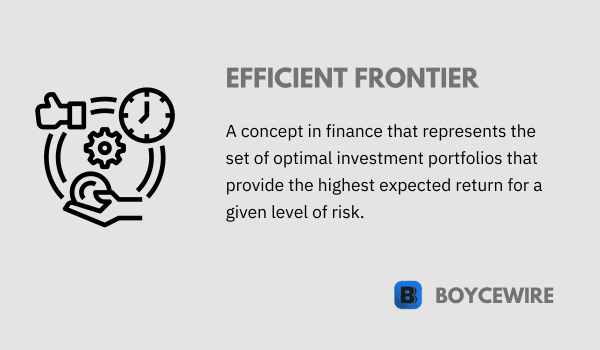Efficient Frontier: Definition, Limitations & Examples

What is Efficient Frontier?
The Efficient Frontier is a graphical representation of all the optimal portfolios that offer the highest expected return for a given level of risk. It embodies the trade-off between risk and return, guiding investors to make informed decisions about their portfolio composition.
Conceptualized by Nobel laureate Harry Markowitz in the 1950s, the Efficient Frontier continues to be a vital tool in portfolio management and financial planning.
Key Points
- The efficient frontier is a concept in portfolio theory that represents the set of optimal portfolios with the highest expected returns for a given level of risk.
- It helps investors identify the portfolio allocation that offers the best risk-return trade-off based on their preferences and risk tolerance.
- The efficient frontier is typically constructed by analyzing historical returns and volatility of different asset classes.
Understanding the Efficient Frontier
The Efficient Frontier is a tool for optimizing a portfolio of investments based on the trade-off between expected return and risk. It is represented graphically, with risk on the x-axis and expected return on the y-axis.
At each point, there is a portfolio that provides the highest possible expected return for a given level of risk. Similarly, there is a portfolio that offers the lowest possible risk for a given level of expected return.
The Efficient Frontier assumes the principle of diversification, which suggests that holding a mix of investments with low or negative correlation can reduce portfolio risk. By spreading investments across different asset classes, an investor can potentially mitigate losses during periods of underperformance.
Portfolios that lie on the Efficient Frontier are considered ‘efficient’ as they offer the best risk-return trade-off. Those that fall below the frontier are deemed ‘inefficient’ as they provide lower returns for the same level of risk.
It’s important to note that the Frontier does not eliminate risk but rather aims to optimize the risk-return relationship. It helps investors construct portfolios that align with their risk tolerance and investment objectives.
Construction of the Efficient Frontier
The construction of the Efficient Frontier involves a multi-step process that requires the knowledge of some crucial financial data for the assets that will be included in the portfolio. Here’s a step-by-step breakdown:
- Identify the Assets The first step in its construction is to identify the set of assets or investments to be included in the portfolio. These assets should be diversified and not perfectly correlated with each other.
- Collect Historical Data Once the assets are identified, historical data needs to be collected for these assets. This typically involves gathering historical prices or other relevant data to calculate returns.
- Calculate Expected Returns and Risks The next step is to calculate the expected returns and risks for each asset. Expected returns are often calculated as the mean returns over a historical period, while risks are typically measured by the standard deviation of returns.
- Determine Correlations It is important to determine the correlations between the returns of the different assets. Lower or negative correlations can help achieve diversification and reduce overall portfolio risk.
- Optimize the Portfolio The final step is to optimize the portfolio by finding the combination of assets that provides the highest return for a given level of risk or the lowest risk for a given level of return. Mathematical optimization techniques and software tools are often used for this purpose.
Once the construction process is complete, the Efficient Frontier can be graphed, representing the risk-return trade-off for the optimal portfolios. Each point on the frontier represents a portfolio with the highest expected return for a given level of risk or the lowest risk for a given level of return. Investors can then select a portfolio on the graph that aligns with their risk tolerance and return objectives.
Optimal Portfolios and the Efficient Frontier
The concept of optimal portfolios and the Efficient Frontier is a cornerstone of Modern Portfolio Theory, introduced by Harry Markowitz in 1952. An optimal portfolio is defined as the one that provides the highest expected return for a given level of risk, or conversely, the lowest risk for a given expected return.
To understand this concept, it is important to visualize the Efficient Frontier as a curve on a graph where the x-axis represents risk (typically standard deviation of the portfolio’s returns), and the y-axis represents expected return. Each point on this curve represents a portfolio composition that maximizes the expected return for a given level of risk.
Therefore, the portfolios that reside on the Frontier are deemed optimal because they yield the maximum possible return for their level of risk. For an investor, the choice among these portfolios will depend on their risk tolerance. A risk-averse investor may opt for a portfolio at the lower end of the curve, accepting lower returns for less risk. Conversely, a risk-tolerant investor may choose a portfolio at the upper end of the curve, willing to accept more risk for higher expected returns.
The Frontier also has an important implication in the context of diversification. It shows that it is possible to construct a portfolio of risky assets that overall has less risk than each individual asset. This is due to the fact that the different assets in the portfolio do not move exactly together (they are not perfectly correlated), which reduces the overall portfolio risk through diversification.
The process of identifying the portfolios that reside on the Efficient Frontier is known as portfolio optimization, a complex procedure that uses quantitative methods to find the best mix of assets.
Applications of the Efficient Frontier
The concept of the Efficient Frontier is widely used in finance, especially in portfolio management and financial modeling. Here are some of the key applications:
- Portfolio Optimization The Frontier plays a critical role in the construction and management of investment portfolios. It allows investors and financial advisors to make informed decisions about portfolio composition based on risk tolerance and return objectives.
- Risk Management By understanding the trade-off between risk and return, risk managers can develop strategies to mitigate risk while achieving desired returns, potentially adjusting portfolio allocations to move towards the Efficient Frontier.
- Asset Allocation The Efficient Frontier helps in determining the appropriate allocation of assets within a portfolio by considering expected returns and associated risks of different asset classes.
- Performance Evaluation The Efficient Frontier can be used as a benchmark to evaluate the performance of managed funds. Portfolios lying below the Frontier indicate inefficient management given the level of risk taken.
- Financial Education and Planning The Efficient Frontier is used in financial education to explain diversification, risk and return trade-off, and the benefits of portfolio optimization. It serves as a fundamental principle in investment strategy planning and decision-making processes.
The Efficient Frontier is a foundational concept in financial theory and practice. However, it’s important to note that its application requires accurate estimates of future returns and volatility, which can be challenging to predict. Additionally, it operates under assumptions, such as investors being rational and markets being efficient, which may not always hold true in real-world scenarios.
Limitations of the Efficient Frontier
While the Efficient Frontier is a powerful tool in financial planning and portfolio management, it has certain limitations:
- Estimation Errors The Efficient Frontier relies on expected returns and standard deviations, which are based on historical data and may not accurately predict future performance. Estimation errors can significantly impact portfolio allocations.
- Simplifying Assumptions The model makes simplifying assumptions about risk, investor behavior, and market efficiency, which may not reflect real-world complexities and variations.
- Single-period Model The standard Efficient Frontier does not consider the multi-period nature of investments and fails to account for changing investor objectives over time.
- Risk Measure The Efficient Frontier uses variance or standard deviation as risk measures, which may not fully capture investor preferences or the asymmetric nature of risk.
- Over-optimization The model can lead to over-optimized portfolios that perform well based on historical data but may not adapt well to changing market conditions.
- Neglect of Taxes and Transaction Costs The model assumes no taxes or transaction costs, which can significantly impact real-world portfolio returns.
The Efficient Frontier is a fundamental concept in portfolio management, but it should be used in conjunction with professional judgment and consideration of individual investor circumstances. Being aware of its limitations can help investors make more informed decisions and avoid over-reliance on the model’s assumptions.
Examples of the Efficient Frontier
Let’s illustrate the concept of the Efficient Frontier with a few examples:
- Two-Asset Portfolio Consider an investor choosing between a high-risk, high-return stock (Asset A) and a low-risk, low-return bond (Asset B). By calculating the expected returns and risks for different portfolio combinations of these two assets, the investor can plot the Efficient Frontier. Portfolios on the frontier will offer the maximum possible return for a given level of risk.
- Multi-Asset Portfolio Imagine an investment scenario with multiple assets, such as stocks, bonds, commodities, and real estate. By calculating the expected returns and risks for different portfolio combinations of these assets, an investor or portfolio manager can plot the Efficient Frontier. Portfolios on the frontier provide the highest expected return for each level of risk.
- Efficient Frontier in Practice Robo-advisors and investment management software utilize the concept of the Efficient Frontier. For example, a robo-advisor constructs a portfolio based on a client’s risk tolerance. By plotting the Efficient Frontier using algorithms, the software identifies an optimized portfolio that offers the highest expected return for the given level of risk.
These examples illustrate the application of the Efficient Frontier in different investment scenarios. However, it’s important to note that real-world portfolio optimization can involve additional complexities, such as taxes, transaction costs, changing market conditions, and a broader range of investment options.
FAQs
The efficient frontier is a concept in portfolio theory that represents the set of optimal portfolios that offer the highest possible expected return for a given level of risk.
The efficient frontier is determined by considering different asset allocations and analyzing their risk-return trade-offs. It is typically constructed by plotting the expected returns and volatility (risk) of various portfolios.
The efficient frontier shows the combinations of assets or portfolios that offer the best risk-return trade-offs. It helps investors identify the most efficient portfolio allocation based on their risk tolerance and return objectives.
The purpose of the efficient frontier is to guide investors in constructing well-diversified portfolios that maximize expected returns for a given level of risk or minimize risk for a given level of expected returns.
About Paul
Paul Boyce is an economics editor with over 10 years experience in the industry. Currently working as a consultant within the financial services sector, Paul is the CEO and chief editor of BoyceWire. He has written publications for FEE, the Mises Institute, and many others.

Further Reading
 Production Function: How to Calculate with Formula & Example - The production function calculates how many inputs you need to create X number of outputs.
Production Function: How to Calculate with Formula & Example - The production function calculates how many inputs you need to create X number of outputs.  Asymmetric Information: Definition, Causes & Examples - Asymmetric information or information asymmetry is where one party in a transaction has more information than the other.
Asymmetric Information: Definition, Causes & Examples - Asymmetric information or information asymmetry is where one party in a transaction has more information than the other.  First Degree Price Discrimination: Definition & Examples - First-degree price discrimination is where a business charges each customer the maximum they are willing to pay.
First Degree Price Discrimination: Definition & Examples - First-degree price discrimination is where a business charges each customer the maximum they are willing to pay. 
